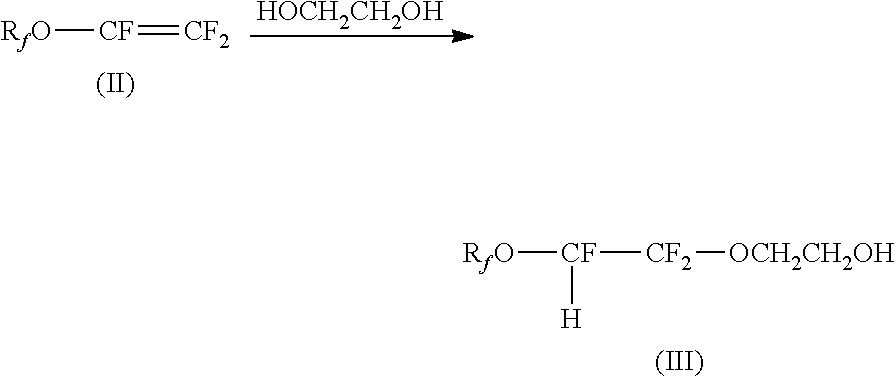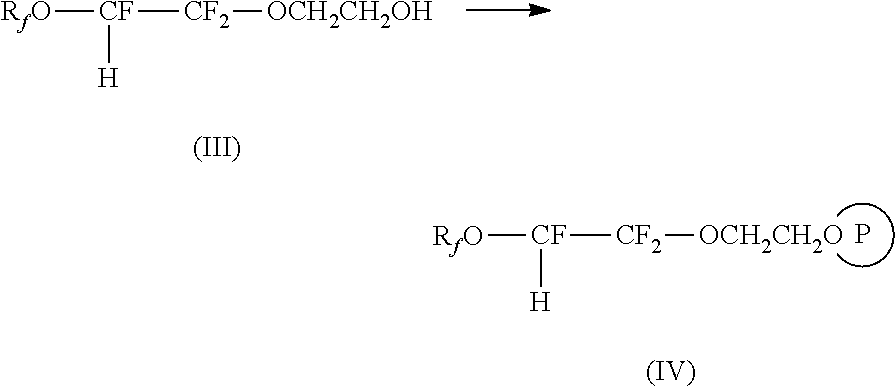Process for the manufacture of fluorosurfactants
a technology of surfactants and manufacturing processes, applied in the preparation of carboxylic compounds, carboxylic acid halides, carboxylic acid salts, etc., can solve the problems of high labor intensity, low yield towards a single particular target compound, and inability to manufacture fully fluorinated carboxylates, etc., to achieve significant reduction of fluorine consumption and high yield
- Summary
- Abstract
- Description
- Claims
- Application Information
AI Technical Summary
Benefits of technology
Problems solved by technology
Method used
Image
Examples
example 2
Synthesis of CF3CF2—O—CF2CF2—O—CF2COONH4 from glycol aldehyde
Ex 2 (a) Addition of Glycol Aldehyde to the Perfluoroethylvinyl Ether
[0072]
[0073]In a four necked round-bottomed glass reactor, equipped with magnetic stirrer, thermometer, condenser maintained at −75° C. (dry ice-Isopropyl alcohol) and two addition funnels, 60 g of glycol aldehyde (1.0 mol) and 62 g of ethylene glycol (1.0 mol) were loaded, followed by 10 g of 37% HCl water solution (0.10 mol HCl) at room temperature; after 1 hour under stirring, the formation of cyclic acetal (G) was complete; the reactor was thus cooled to 0° C. with an ice water bath, then a solution of 44 g (1.1 mol) of NaOH (s) and 44 ml of distilled water H2O was added in half an hour. After a slight exothermicity, at 0° C., 216 g (1.0 mmol) of (A) were slowly added. At the end of the addition, the reaction mixture was allowed to reach 20° C., and stirred for another 2 hours. The crude mixture was extracted three times with tetrahydrofuran (THF). Th...
example 3
Synthesis of CF3CF2—O—CF2CF2—O—CF2COONH4 from glycolic acid
Ex. 3(a) Addition of Glycolic Acid to the Perfluoroethylvinyl Ether
[0081]
[0082]In a four necked round-bottomed glass reactor, equipped with magnetic stirrer, thermometer, condenser maintained at −75° C. (dry ice-Isopropyl alcohol) and two addition funnels, 76 g of glycolic acid (1.0 mol) were loaded, followed by a solution of 84 g (2.1 mol) of NaOH (s) in 300 ml of distilled water H2O; the reactor was cooled to 0° C. with an ice water bath. 216 g (1.0 mol) of CF2═CFOCF2CF3 were slowly added. At the end of the addition the reaction mixture was allowed to reach 20° C., and stirred for another 3 hours. Then suitable amounts of a 37% HCl water solution were added until achieving a pH=1. The acidified mixture was then extracted three times with THF. Combined THF phases were dehydrated with MgSO4, filtered and fractionally distilled for recovering acid adduct (K). 215 g of the partially hydrogenated acid adduct (K) were collected ...
PUM
| Property | Measurement | Unit |
|---|---|---|
| temperature | aaaaa | aaaaa |
| temperature | aaaaa | aaaaa |
| temperature | aaaaa | aaaaa |
Abstract
Description
Claims
Application Information
 Login to View More
Login to View More - R&D
- Intellectual Property
- Life Sciences
- Materials
- Tech Scout
- Unparalleled Data Quality
- Higher Quality Content
- 60% Fewer Hallucinations
Browse by: Latest US Patents, China's latest patents, Technical Efficacy Thesaurus, Application Domain, Technology Topic, Popular Technical Reports.
© 2025 PatSnap. All rights reserved.Legal|Privacy policy|Modern Slavery Act Transparency Statement|Sitemap|About US| Contact US: help@patsnap.com



